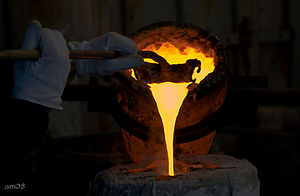Digital lost wax for metal casting: Difference between revisions
Jump to navigation
Jump to search
m (→Links: fixed link) |
mNo edit summary |
||
| Line 1: | Line 1: | ||
[[File:Lost_wax_for_bronze_casting.jpg|300px|thumb|right|Lost wax for bronze casting]] | [[File:Lost_wax_for_bronze_casting.jpg|300px|thumb|right|Lost wax for bronze casting]] | ||
The digital 3D model is rendered in wax, then the [http://en.wikipedia.org/wiki/Lost-wax_casting lost wax] technique is used to make the metal object. The process is used extensively in rapid prototyping, jewelry making and bronze sculpture art. Different options are available for turning the 3D model into a wax model: 1.) liquid wax is printed, or 2.) the object is carved | The digital 3D model is rendered in wax, then the [http://en.wikipedia.org/wiki/Lost-wax_casting lost wax] technique is used to make the metal object. The process is used extensively in rapid prototyping, jewelry making and bronze sculpture art. Different options are available for turning the 3D model into a wax model: 1.) liquid wax is printed, or 2.) the object is carved/milled out of a solid wax block (subtractive). | ||
==Product ecology== | ==Product ecology== | ||
Revision as of 03:33, 7 February 2011
The digital 3D model is rendered in wax, then the lost wax technique is used to make the metal object. The process is used extensively in rapid prototyping, jewelry making and bronze sculpture art. Different options are available for turning the 3D model into a wax model: 1.) liquid wax is printed, or 2.) the object is carved/milled out of a solid wax block (subtractive).
Product ecology
- use induction furnace to melt metals
- use beeswax for wax block ?
Links
- OSE Wiki page on Metal Casting
- Wikipedia: Lost-wax casting
